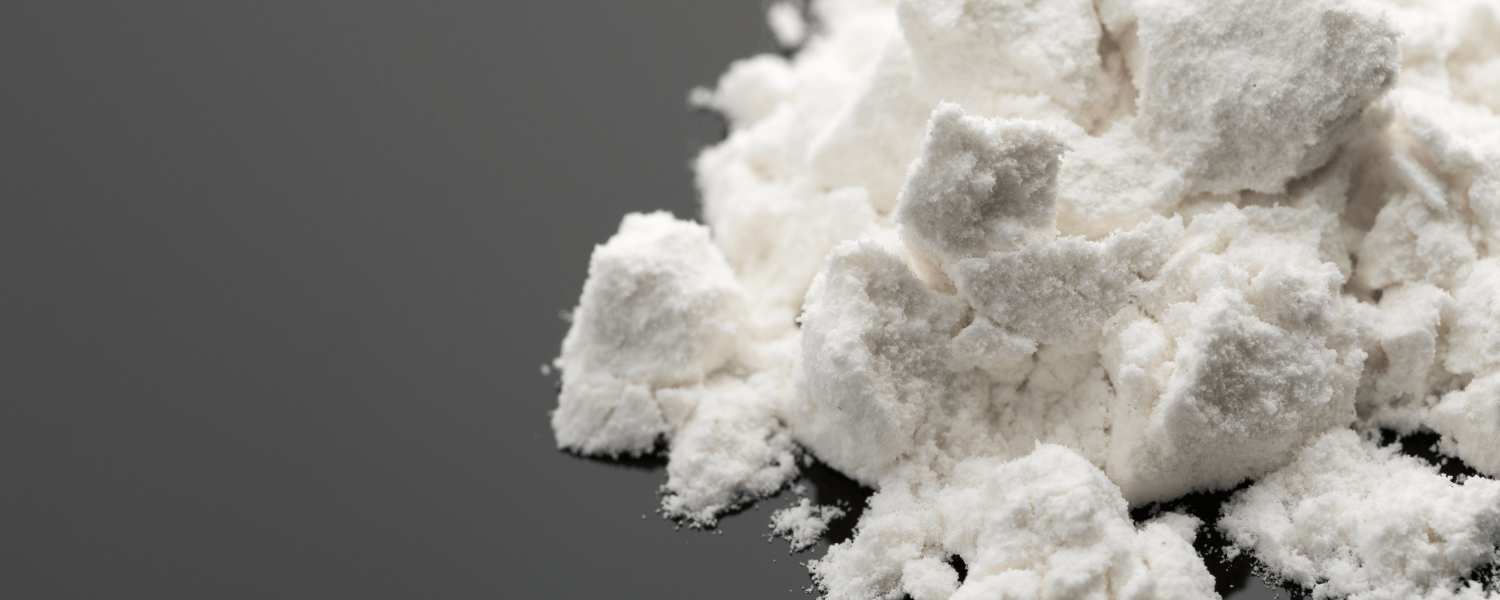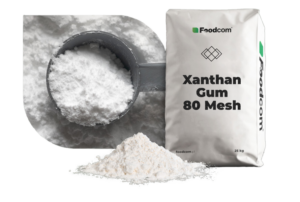Today’s food and cosmetics industry is constantly looking for raw materials to increase the quality, yield and stability of products, without compromising on safety or naturalness. One such ingredient is xanthan gum – also known as E415. Although at first glance it may appear to be a mere technological additive, it is in fact an important component that affects the texture, stability and functionality of many of the products we encounter every day.
What exactly is xanthan gum?
Xanthan gum is a natural polysaccharide obtained through the fermentation of sugars by the bacteria Xanthomonas campestris. It is from the name of this microorganism that the term xanthan is derived. The product takes the form of a fine powder with a whitish or slightly yellowish colour and is completely soluble in water.
It is most often found on food labels under the code E415, which classifies it as an approved functional additive. However, unlike many synthetic thickeners, xanthan is distinguished by its microbial origin and its high compatibility with other raw materials – both natural and synthetic.
Properties of xanthan gum that translate into product quality
The multi-purpose nature of xanthan gum is due to its unique physicochemical properties, which are appreciated by food technologists, cosmetologists and pharmaceutical manufacturers. Among the most important are:
- strong thickening properties – even a small amount of xanthan can significantly increase the viscosity of liquids,
- stability over a wide range of pH and temperatures – ideal for use in heated or acidic products (e.g. sauces, dressings),
- ability to form stable emulsions and suspensions – particularly important in the cosmetics and pharmaceutical industries,
- resistance to environmental conditions – retains its properties even under harsh production conditions,
- is tasteless and odourless – does not affect the sensory profile of the finished product.
Types of xanthan gum – match the raw material to your specific needs
Various types of xanthan gum are available on the market, with the two most popular variants being:
- 80 mesh xanthan gum – has larger particles, which makes it slower to dissolve. It is often chosen for applications where the dissolution process can be controlled,
- 200 mesh xanthan gum – a finely ground version that dissolves quickly, giving an immediate thickening effect. It is ideal for cosmetic products, creams, sauces and quick-mix formulations.
Choosing the right type depends on the specifics of your production line and the final effect you want to achieve.
Applications of xanthan gum – from food to cosmetics
The use of xanthan is extremely wide – it is one of the most widely used thickeners in the world. Depending on the industry, the substance may have slightly different functions.
In the food industry
Xanthan gum is an indispensable ingredient in manufacturing:
- sauces and dressings (prevents delamination),
- soups, creams and concentrates (improves texture),
- desserts, ice-cream and dairy drinks (smoothing),
- gluten-free foods (substitutes gluten, improves flexibility in baked goods),
- low-fat products (improves greasiness).
In cosmetics
In the cosmetics industry, xanthan acts as a natural gel, stabiliser and thickener. It can be found in, among others:
- face and body creams,
- shower gels and shampoos,
- masks and scrubs,
- colour cosmetics (e.g. foundations, concealers).
It improves application, increases comfort and stabilises active ingredients.
In the pharmaceutical and chemical industry
Xanthan is used in the formulation of capsules, syrups, and as an ingredient in cleaning agents or detergents, where solution stability and viscosity are essential.
Xanthan gum production – natural process, industrial scale
The production of xanthan gum begins with the fermentation of sugars (e.g. glucose, sucrose, maize) by the bacteria Xanthomonas campestris. The solution is then purified, filtered and dried. The finished product takes the form of a fine powder, which can then be ground into the appropriate fraction (e.g. 80 or 200 mesh).
The entire process is carried out in accordance with HACCP, ISO and food and cosmetic industry standards, which guarantees the quality and safety of the final raw material.
Where to buy xanthan gum? FDCM.eu platform
If you are wondering where to buy high-quality xanthan gum – look no further. The most convenient option is to buy online at FDCM.eu, a professional purchasing platform for companies in the food and cosmetics industry. As a modern wholesaler of food raw materials, FDCM.eu offers not only attractive prices, but also full technical and logistical support.
What’s more, you can order a free sample with delivery to test how xanthan gum 80 mesh or 200 mesh will perform in your application.
Why buy raw materials online?
Buying raw materials online is an increasingly common choice for manufacturing companies – and for good reason. With FDCM.eu, you have access to:
- an intuitive purchasing system,
- fast handling and dispatch,
- accurate specifications and certificates for your raw materials,
- competitive wholesale prices,
- secure transactions and flexible payment methods.
This is the answer to the question – how to order food raw materials online in a modern, secure and convenient way.
Xanthan gum for industry – order a sample and buy conveniently online
Xanthan gum is one of the most versatile ingredients in modern production – both food and cosmetics. Its functionality, natural origin and wide application make it the choice of hundreds of companies worldwide.
Whether you need 80 mesh xanthan gum for food or 200 mesh for cosmetics – you will find the proven raw material at FDCM.eu. Don’t forget to order a free sample with delivery before you decide to buy in bulk. In this way, you will match the ideal type of xanthan to your production needs and avoid unnecessary costs.







